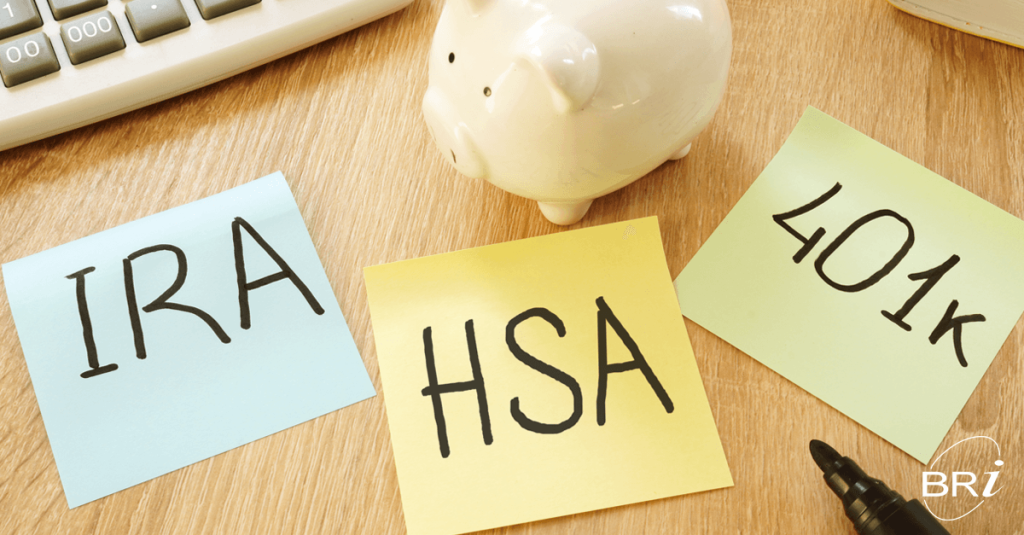We all have the best of intentions for retirement savings, but we can’t fund everything. Here are three rules to follow to get the right blend from three of the most common retirement account options:
First, don’t leave money on the table.
As the saying goes, “Don’t leave money on the table”. This is very true when considering your approach to retirement savings.
Make sure you are getting the 401(k) match
Many employers will offer a 401(k) match up to a certain percentage. Let’s say your employer will contribute 50 cents on every dollar, up to 4% of your salary. If you are making $40,000, that means you will contribute 4% (or $1,600) annually. Your employer then kicks in another $800 on your behalf. (That is a 50% return on your investment.) Additionally, contributions to a 401(k) are made with pre-tax dollars, so you save on taxes as well.
Verify HSA contributions, incentives or matching programs
Employers can structure HSA contributions in a variety of ways. They may use one or even all of the options at the same time.
Flat Dollar HSA Contributions
When an employer decides to make flat dollar contributions, typically, all you need to do to receive the contribution is have an open HSA. This is pretty simple in most cases. However, since HSAs are individually owned, you may be asked to verify your identity during the account opening process. Make sure you provide the required documentation and open that HSA.
HSA Incentive Contributions
There are many flavors that an HSA incentive program takes on. You may receive an HSA contribution for completing a health risk assessment, logging activities, or completing a coaching program or biometric screening. Pay close attention to the details of the incentives and the time frames. What action needs to be taken? What do you need to do to show that you took that action? When will HSA contributions occur?
HSA Contribution Matching Programs
Just like 401k matching programs, more employers are offering HSA matching programs. For example, if you elect a $500 HSA contribution through payroll, your employer may match it as well.
Second, contribute the HSA maximum
You followed the first rule and didn’t leave anything on the table. You are feeling good and are prepared to save a little more. Where do you contribute next?
An HSA, of course.
We understand you may be skeptical. While we might have a slight bias for HSAs, it really is the best choice for your pocket book (and peace of mind):
- An HSA is the only retirement account that is completely tax-free when used for eligible medical expenses.
- At age 65, you can take the money out for other purposes and it receives the same tax treatment as an IRA.
- Alternatively, there is an additional upside for all those receipt hoarders. Let’s say over the life of your HSA you incurred exactly $50,000 in medical expenses. You paid those expenses with other funds and let your HSA balance build. Then, in retirement, you decide to buy a boat for exactly $50,000. Because you saved all your medical receipts, you can reimburse yourself out of the HSA tax-free and use the funds for anything.
- There are going to be medical expenses. According to Fidelity, it is estimated that the average couple will need $280,000 in today’s dollars for medical expenses in retirement, excluding long-term care. That’s a lot of opportunities to use your HSA tax-free.
The IRS changes the HSA contribution limits each year. Be sure to check out the 2020 HSA Contribution Limits.
Finally, fill your 401(k) and IRA buckets
If you are still looking for additional retirement savings opportunities, it is time to consider those 401(k) and IRA contributions.
- For 2020, you can contribute up to $19,500 annually to a 401(k). If you find yourself under the annual limit and receive a year-end bonus, consider a one-time bump to your 401(k) contributions.
- There are Roth IRAs and Traditional IRAs. We are not going to pretend to know what’s best for you. Talk to a financial advisor to understand what option makes the most sense for you. The IRS also provides some clarity on the differences. Income limits, filing status and various other financial scenarios affect your account decision. The advantage to an IRA is that you have until the tax filing deadline (typically April 15) to contribute to an IRA for the prior year.
Make sure you are on the right path to retirement savings, even if COVID-19 made you pivot on your approach to your 401(k) or HSA. Check out 4 Life Hacks to Extend the Value of Your Benefits.


